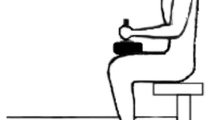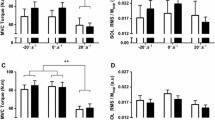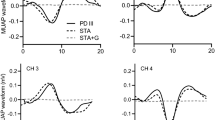Abstract
Parallel increases in strength and rate of force development (RFD) are well-known outcomes from the initial phase of resistance training. However, it is unknown whether neural adaptations with training contribute to improvements of both factors. The aim of this study was to examine whether changes in H-reflex amplitude with resistance training can explain the gain in strength or rather be associated with RFD. Twelve subjects carried out 3 weeks of isometric maximal plantarflexion training, whereas 12 subjects functioned as contr ols. H-reflexes were elicited in the soleus muscle during rest and sub-maximal contractions at 20 and 60% of maximal voluntary contraction (MVC). In addition, surface electromyography (sEMG) was recorded from the soleus, gastrocnemius and tibialis anterior muscles during MVC. The resistance training provided increases in maximal force of 18%, RFD of 28% and H-reflex amplitude during voluntary contractions of 17 and 15% while no changes occurred in the control group. In contrast, the maximal M-wave, the maximal H-reflex to maximal M-wave ratio during rest and sEMG during MVC did not change with training. There was a positive correlation between percentage changes in H-reflex amplitude and RFD with training (r = 0.59), while significant association between percentage changes in H-reflex amplitude and maximal force was not found. These findings indicate the occurrence of changed motoneuron excitability or presynaptic inhibition during the initial phase of resistance training. This is the first study to document that increased RFD with resistance training is associated with changes in reflex excitability.






Similar content being viewed by others

References
Aagaard P, Simonsen EB, Andersen JL, Magnusson P, Dyhre-Poulsen P (2002) Increased rate of force development and neural drive of human skeletal muscle following resistance training. J Appl Physiol 93:1318–1326
Aagaard P, Simonsen EB, Andersen JL, Magnusson P, Dyhre-Poulsen P (2002) Neural adaptation to resistance training: changes in evoked V-wave and H-reflex responses. J Appl Physiol 92:2309–2318
Almeida-Silveira MI, Perot C, Goubel F (1996) Neuromuscular adaptations in rats trained by muscle stretch-shortening. Eur J Appl Physiol Occup Physiol 72:261–266
Andersen LL, Aagaard P (2006) Influence of maximal muscle strength and intrinsic muscle contractile properties on contractile rate of force development. Eur J Appl Physiol 96:46–52
Behm DG, Sale DG (1993) Intended rather than actual movement velocity determines velocity-specific training response. J Appl Physiol 74:359–368
Binder-Macleod SA, Barrish WJ (1992) Force response of rat soleus muscle to variable-frequency train stimulation. J Neurophysiol 68:1068–1078
Buller AJ, Lewis DM (1965) The rate of tension development in isometric tetanic contractions of mammalian fast and slow skeletal muscle. J Physiol 176:337–354
Burke D, Adams RW, Skuse NF (1989) The effects of voluntary contraction on the H reflex of human limb muscles. Brain 112:417–433
Butler AJ, Yue GH, Darling WG (1993) Variations in soleus H-reflexes as a function of plantarflexion torque in man. Brain Res 632:95–104
Cannon RJ, Cafarelli E (1987) Neuromuscular adaptations to training. J Appl Physiol 63:2396–2402
Capaday C (1997) Neurophysiological methods for studies of the motor system in freely moving human subjects. J Neurosci Methods 74:201–218
Capaday C, Stein RB (1987) Difference in the amplitude of the human soleus H reflex during walking and running. J Physiol 392:513–522
Carolan B, Cafarelli E (1992) Adaptations in coactivation after isometric resistance training. J Appl Physiol 73:911–917
Casabona A, Polizzi MC, Perciavalle V (1990) Differences in H-reflex between athletes trained for explosive contractions and non-trained subjects. Eur J Appl Physiol Occup Physiol 61:26–32
Chapman JP, Chapman LJ, Allen JJ (1987) The measurement of foot preference. Neuropsychologia 25:579–584
De Leon RD, Hodgson JA, Roy RR, Edgerton VR (1998) Full weight-bearing hindlimb standing following stand training in the adult spinal cat. J Neurophysiol 80:83–91
Earles DR, Dierking JT, Robertson CT, Koceja DM (2002) Pre- and post-synaptic control of motoneuron excitability in athletes. Med Sci Sports Exerc 34:1766–1772
Enoka RM (1997) Neural adaptations with chronic physical activity. J Biomech 30:447–455
Enoka RM (1988) Muscle strength and its development. New perspectives. Sports Med 6:146–168
Farina D, Merletti R, Enoka RM (2004) The extraction of neural strategies from the surface EMG. J Appl Physiol 96:1486–1495
Gabriel DA, Kamen G, Frost G (2006) Neural adaptations to resistive exercise: mechanisms and recommendations for training practices. Sports Med 36:133–149
Gerilovsky L, Tsvetinov P, Trenkova G (1985) Is the M max/H max ratio a reliable index of the monosynaptic excitability in man? Recruitment curves for H- and M-responses using monopolar and bipolar recording techniques. Acta Physiol Pharmacol Bulgarica 11:42–49
Gerilovsky L, Tsvetinov P, Trenkova G (1989) Peripheral effects on the amplitude of monopolar and bipolar H-reflex potentials from the soleus muscle. Exp Brain Res 76:173–181
Gollhofer A, Schopp A, Rapp W, Stroinik V (1998) Changes in reflex excitability following isometric contraction in humans. Eur J Appl Physiol Occup Physiol 77:89–97
Goulart F, Valls-Sole J, Alvarez R (2000) Posture-related changes of soleus H-reflex excitability. Muscle Nerve 23:925–932
Griffin L, Cafarelli E (2005) Resistance training: cortical, spinal, and motor unit adaptations. Can J Appl Physiol 30:328–340
Haff GG, Carlock JM, Hartman MJ, Kilgore JL, Kawamori N, Jackson JR, Morris RT, Sands WA, Stone MH (2005) Force-time curve characteristics of dynamic and isometric muscle actions of elite women olympic weightlifters. J Strength Condition Res 19:741–748
Hakkinen K, Kallinen M, Izquierdo M, Jokelainen K, Lassila H, Malkia E, Kraemer WJ, Newton RU, Alen M (1998) Changes in agonist-antagonist EMG, muscle CSA, and force during strength training in middle-aged and older people. J Appl Physiol 84:1341–1349
Hakkinen K, Komi PV (1986) Training-induced changes in neuromuscular performance under voluntary and reflex conditions. Eur J Appl Physiol Occup Physiol 55:147–155
Hakkinen K, Komi PV, Alen M (1985) Effect of explosive type strength training on isometric force- and relaxation-time, electromyographic and muscle fibre characteristics of leg extensor muscles. Acta Physiol Scandinavica 125:587–600
Hayes KC, Sullivan J (1976) Tonic neck reflex influence on tendon and Hoffmann reflexes in man. Electromyogr Clin Neurophysiol 16:251–261
Holtermann A, Roeleveld K, Vereijken B, Ettema GJ (2007) The effect of rate of force development on maximal force generation: acute and training-related aspects. Eur J Appl Physiol 99:605–613
Holtermann A, Roeleveld K, Vereijken B, Ettema GJC (2005) Changes in agonist EMG activation level during MVC cannot explain early strength improvement. Eur J Appl Physiol 94:593–601
Hopkins JT, Ingersoll CD, Cordova ML, Edwards JE (2000) Intrasession and intersession reliability of the soleus H-reflex in supine and standing positions. Electromyogr Clin Neurophysiol 40:89–94
Keen DA, Yue GH, Enoka RM (1994) Training-related enhancement in the control of motor output in elderly humans. J Appl Physiol 77:2648–2658
Knikou M, Rymer W (2002) Effects of changes in hip joint angle on H-reflex excitability in humans. Exp Brain Res 143:149–159
Koceja DM, Kamen G (1992) Segmental reflex organization in endurance-trained athletes and untrained subjects. Med Sci Sports Exerc 24:235–241
Kukulka CG, Clamann HP (1981) Comparison of the recruitment and discharge properties of motor units in human brachial biceps and adductor pollicis during isometric contractions. Brain Res 219:45–55
Lagerquist O, Zehr EP, Docherty D (2006) Increased spinal reflex excitability is not associated with neural plasticity underlying the cross-education effect. J Appl Physiol 100:83–90
Maffiuletti NA, Martin A, Babault N, Pensini M, Lucas B, Schieppati M (2001) Electrical and mechanical H(max)-to-M(max) ratio in power- and endurance-trained athletes. J Appl Physiol 90:3–9
Meunier S, Pierrot-Deseilligny E (1989) Gating of the afferent volley of the monosynaptic stretch reflex during movement in man. J Physiol 419:753–763
Miller RG, Mirka A, Maxfield M (1981) Rate of tension development in isometric contractions of a human hand muscle. Exp Neurol 73:267–285
Milner-Brown HS, Stein RB (1975) The relation between the surface electromyogram and muscular force. J Physiol 246:549–569
Mineva A, Dushanova J, Gerilovsky L (1993) Similarity in shape, timing and amplitude of H- and T-reflex potentials concurrently recorded along the broad skin area over soleus muscle. Electromyogr Clin Neurophysiol 33:235–245
Mirkov DM, Nedeljkovic A, Milanovic S, Jaric S (2004) Muscle strength testing: evaluation of tests of explosive force production. Eur J Appl Physiol 91:147–154
Misiaszek JE (2003) The H-reflex as a tool in neurophysiology: its limitations and uses in understanding nervous system function. Muscle Nerve 28:144–160
Moritani T (2002) Motor unit and motoneurone excitability during explosive movement. In: Komi PV (ed) Strength and power in sport, pp 27–49
Moritani T (1993) Neuromuscular adaptations during the acquisition of muscle strength, power and motor tasks. J Biomech 26:95–107
Moritani T, deVries HA (1979) Neural factors versus hypertrophy in the time course of muscle strength gain. Am J Phys Med 58:115–130
Muir GD, Steeves JD (1995) Phasic cutaneous input facilitates locomotor recovery after incomplete spinal injury in the chick. J Neurophysiol 74:358–368
Nielsen J, Crone C, Hultborn H (1993) H-reflexes are smaller in dancers from The Royal Danish Ballet than in well-trained athletes. Eur J Appl Physiol Occup Physiol 66:116–121
Nielsen J, Kagamihara Y (1993) The regulation of presynaptic inhibition during co-contraction of antagonistic muscles in man. J Physiol 464:575–593
Patten C, Kamen G, Rowland DM (2001) Adaptations in maximal motor unit discharge rate to strength training in young and older adults. Muscle Nerve 24:542–550
Pierrot-Deseilligny E, Mazevet D (2000) The monosynaptic reflex: a tool to investigate motor control in humans. Interest and limits. Clin Neurophysiol 30:67–80
Pucci AR, Griffin L, Cafarelli E (2006) Maximal motor unit firing rates during isometric resistance training in men. Exp Physiol 91:171–178
Rabita G, Perot C, Lensel-Corbeil G (2000) Differential effect of knee extension isometric training on the different muscles of the quadriceps femoris in humans. Eur J Appl Physiol 83:531–538
Rich C, Cafarelli E (2000) Submaximal motor unit firing rates after 8 wk of isometric resistance training. Med Sci Sports Exerc 32:190–196
Robinson KL, McIlwain JS, Hayes KC (1979) Effects of H-reflex conditioning upon the contralateral alpha motoneuron pool. Electroencephalogr Clin Neurophysiol 46:65–71
Rudomin P, Schmidt RF (1999) Presynaptic inhibition in the vertebrate spinal cord revisited. Exp Brain Res 129:1–37
Sale DG, MacDougall JD, Upton AR, McComas AJ (1983) Effect of strength training upon motoneuron excitability in man. Med Sci Sports Exerc 15:57–62
Sale DG, Martin JE, Moroz DE (1992) Hypertrophy without increased isometric strength after weight training. Eur J Appl Physiol Occup Physiol 64:51–55
Scaglioni G, Ferri A, Minetti AE, Martin A, Van Hoecke J, Capodaglio P, Sartorio A, Narici MV (2002) Plantar flexor activation capacity and H reflex in older adults: adaptations to strength training. J Appl Physiol 92:2292–2302
Schieppati M (1987) The Hoffmann reflex: a means of assessing spinal reflex excitability and its descending control in man. Progr Neurobiol 28:345–376
Simonsen EB, Dyhre-Poulsen P (1999) Amplitude of the human soleus H reflex during walking and running. J Physiol 515:929–939
Suetta C, Aagaard P, Rosted A, Jakobsen AK, Duus B, Kjaer M, Magnusson P (2004) Training-induced changes in muscle CSA, muscle strength, EMG, and rate of force development in elderly subjects after long-term unilateral disuse. J Appl Physiol 7:1954–1961
Thorstensson A, Karlsson J, Viitasalo JH, Luhtanen P, Komi PV (1976) Effect of strength training on EMG of human skeletal muscle. Acta Physiol Scandinavica 98:232–236
Van Cutsem M, Duchateau J, Hainaut K (1998) Changes in single motor unit behaviour contribute to the increase in contraction speed after dynamic training in humans. J Physiol 513:295–305
Voigt M, Chelli F, Frigo C (1998) Changes in the excitability of soleus muscle short latency stretch reflexes during human hopping after 4 weeks of hopping training. Eur J Appl Physiol Occup Physiol 78:522–532
Wolpaw JR, Tennissen AM (2001) Activity-dependent spinal cord plasticity in health and disease. Annu Rev Neurosci 24:807–843
Yue GH, Cole KJ (1992) Strength increases from the motor program: comparison of training with maximal voluntary and imagined muscle contractions. J Neurophysiol 67:1114–1123
Yue GH, Ranganathan VK, Siemionow V, Liu JZ, Sahgal V (2000) Evidence of inability to fully activate human limb muscle. Muscle Nerve 23:376–384
Zehr PE (2002) Considerations for use of the Hoffman reflex in excercise studies. Eur J Appl Physiol 86:455–468
Acknowledgments
We would like to thank Jørgen Ingebrigtsen of Human Movement Sciences program, Norwegian University of Science and Technology, Trondheim, Norway, for his contribution with the data collection and resistance training.
Author information
Authors and Affiliations
Corresponding author
Rights and permissions
About this article
Cite this article
Holtermann, A., Roeleveld, K., Engstrøm, M. et al. Enhanced H-reflex with resistance training is related to increased rate of force development. Eur J Appl Physiol 101, 301–312 (2007). https://doi.org/10.1007/s00421-007-0503-y
Accepted:
Published:
Issue Date:
DOI: https://doi.org/10.1007/s00421-007-0503-y



